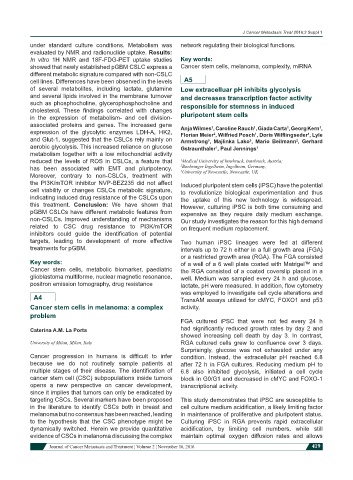Page 429 - Read Online
P. 429
J Cancer Metastasis Treat 2016;2 Suppl 1
under standard culture conditions. Metabolism was network regulating their biological functions.
evaluated by NMR and radionuclide uptake. Results:
In vitro 1H NMR and 18F-FDG-PET uptake studies Key words:
showed that newly established pGBM CSLC express a Cancer stem cells, melanoma, complexity, miRNA
different metabolic signature compared with non-CSLC
cell lines. Differences have been observed in the levels A5
of several metabolites, including lactate, glutamine Low extracelluar pH inhibits glycolysis
and several lipids involved in the membrane turnover and decreases transcription factor activity
such as phosphocholine, glycerophosphocholine and responsible for stemness in induced
cholesterol. These findings correlated with changes
in the expression of metabolism- and cell division- pluripotent stem cells
associated proteins and genes. The increased gene Anja Wilmes , Caroline Rauch , Giada Carta , Georg Kern ,
1
1
1
1
expression of the glycolytic enzymes LDH-A, HK2, Florian Meier , Wilfried Posch , Doris Wilflingseder , Lyle
1
1
2
and Glut-1, suggested that the CSLCs rely mainly on Armstrong , Majlinka Lako , Mario Beilmann , Gerhard
3
3
2
aerobic glycolysis. This increased reliance on glucose Gstraunthaler , Paul Jennings 1
1
metabolism together with a low mitochondrial activity
reduced the levels of ROS in CSLCs, a feature that 1 Medical University of Innsbruck, Innsbruck, Austria;
has been associated with EMT and pluripotency. 2 3 Boehringer Ingelheim, Ingelheim, Germany;
University of Newcastle, Newcastle, UK
Moreover, contrary to non-CSLCs, treatment with
the PI3K/mTOR inhibitor NVP-BEZ235 did not affect Induced pluripotent stem cells (iPSC) have the potential
cell viability or changes CSLCs metabolic signature, to revolutionize biological experimentation and thus
indicating induced drug resistance of the CSLCs upon the uptake of this new technology is widespread.
this treatment. Conclusion: We have shown that However, culturing iPSC is both time consuming and
pGBM CSLCs have different metabolic features from expensive as they require daily medium exchange.
non-CSLCs. Improved understanding of mechanisms Our study investigates the reason for this high demand
related to CSC drug resistance to PI3K/mTOR on frequent medium replacement.
inhibitors could guide the identification of potential
targets, leading to development of more effective Two human iPSC lineages were fed at different
treatments for pGBM. intervals up to 72 h either in a full growth area (FGA)
or a restricted growth area (RGA). The FGA consisted
Key words: of a well of a 6 well plate coated with Matrigel™ and
Cancer stem cells, metabolic biomarker, paediatric the RGA consisted of a coated coverslip placed in a
glioblastoma multiforme, nuclear magnetic resonance, well. Medium was sampled every 24 h and glucose,
positron emission tomography, drug resistance lactate, pH were measured. In addition, flow cytometry
was employed to investigate cell cycle alterations and
A4 TransAM assays utilized for cMYC, FOXO1 and p53
Cancer stem cells in melanoma: a complex activity.
problem
FGA cultured iPSC that were not fed every 24 h
Caterina A.M. La Porta had significantly reduced growth rates by day 2 and
showed increasing cell death by day 3. In contrast,
University of Milan, Milan, Italy RGA cultured cells grew to confluence over 3 days.
Surprisingly, glucose was not exhausted under any
Cancer progression in humans is difficult to infer condition. Instead, the extracellular pH reached 6.8
because we do not routinely sample patients at after 72 h in FGA cultures. Reducing medium pH to
multiple stages of their disease. The identification of 6.8 also inhibited glycolysis, initiated a cell cycle
cancer stem cell (CSC) subpopulations inside tumors block in G0/G1 and decreased in cMYC and FOXO-1
opens a new perspective on cancer development, transcriptional activity.
since it implies that tumors can only be eradicated by
targeting CSCs. Several markers have been proposed This study demonstrates that iPSC are susceptible to
in the literature to identify CSCs both in breast and cell culture medium acidification, a likely limiting factor
melanoma but no consensus has been reached, leading in maintenance of proliferative and pluripotent status.
to the hypothesis that the CSC phenotype might be Culturing iPSC in RGA prevents rapid extracellular
dynamically switched. Herein we provide quantitative acidification, by limiting cell numbers, while still
evidence of CSCs in melanoma discussing the complex maintain optimal oxygen diffusion rates and allows
Journal of Cancer Metastasis and Treatment ¦ Volume 2 ¦ November 16, 2016 419

